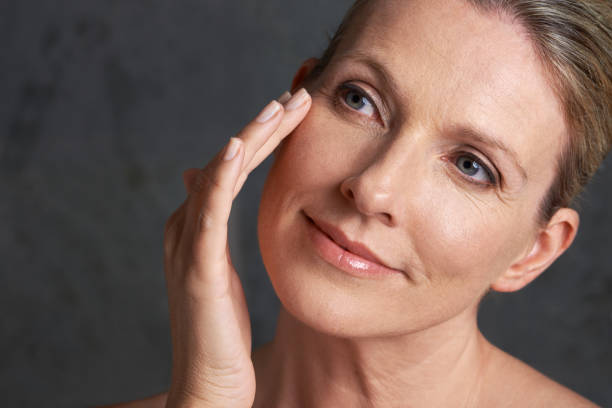Well, in the realm of anti-aging skincare, the routines and products do indeed vary between men and women. Such differences emanate from biological and hormonal causes, as well as lifestyle-related issues. In any case, whether man or woman, people want to erase the look of aging; however, due to different characteristics of the skin, its needs best serum for dry skin for glow, and appearance, a male’s anti-aging skincare routine will be different from a female’s. Let’s now see it in more detail.
- Skin Structure and Thickness
Men: The skin of men is thicker and richer with a higher level of collagen. For this reason, men are able to maintain the structure of the skin and firmness for longer. For men, it also usually translates into fewer wrinkles and sagging earlier than in women. However, their skin is oilier due to larger sebaceous glands that eventually cause acne or shine. Thus, oil control has to be incorporated together with anti-aging in skincare routines.
Women: Women’s skin is usually thinner and more fragile, especially with age. Naturally, the levels of estrogen start to decrease in women during menopause. This results in a loss of collagen and elastin, and visible signs of aging become more obvious, such as wrinkles and sagging of the skin. So, staying hydrated and repairing their skin barrier, as well as products that help to promote collagen, take precedence in women‘s anti-aging skincare routines.
- Hormonal Factors
Men: Testosterone is a major player in men‘s skin. It encourages oil production and keeps the skin feeling firmer. Men‘s skin is less susceptible to the fine lines women get, but as testosterone levels decline with age, men may find their skin dries out more easily. Anti-aging products for men tend to balance oil control with hydration, targeting both aging signs and excess sebum.
Women: Estrogen is the primary hormone influencing women’s skin, and its loss at menopause speeds up the degradation of collagen. This loss causes the skin to become thinner, wrinkles to appear deeper, and elasticity to be reduced. Consequently, women‘s anti-aging products are often moisturizing, firming, and collagen-enhancing. Peptides and retinoids are some of the most common ingredients in women‘s regimens for addressing these age-related changes.
- Shaving and Grooming
Men: Shaving is a regular routine for most men; it provides some form of natural exfoliation that smoothens over the dead skin cells and promotes cell turnover. However, at the same time, it risks being a major irritant source leading to redness and razor burn. In men‘s anti-aging products, soothing agents such as aloe vera, chamomile, and tea tree oil are generally found to calm the skin and diminish post-shave sensitivity. Men may also require products that prevent ingrown hairs or reduce pore clogging by oil.
Women: Though most women do not shave daily, other hair removal techniques, such as waxing or threading, can also influence the health of the skin by causing irritation, dryness, or post-inflammatory pigmentation. In contrast, these are usually fewer than the stress on the skin due to daily shaving. The anti-aging regimen of a woman might include exfoliating treatments or serums to reduce any irritation due to these treatments.
- Product Formulations
Men: Men tend to like skincare products that are simple, fast-absorbing, and non-greasy. The focus is often on lightweight, practical formulations that fit into a quick grooming routine. Men’s products tend to avoid heavy fragrances, as these can irritate the skin, especially after shaving. Anti-aging formulations for men may include mattifying ingredients to control oil production while providing anti-aging benefits like wrinkle reduction.
Women: Women usually have more intricate skincare routines that may consist of several steps. Hydration, in particular, is a very important concern so women‘s products are usually those richer, nourishing anti-aging products. Multi-functional moisturizers with added anti-aging actives—such as vitamin C or peptides—tend to be popular for these products to help address multiple signs of aging – such as wrinkles, discoloration, and sagging while working on hydration and texture.
- Common Ingredients Used in Both Men’s and Women’s Skincare
Although key anti-aging ingredients shared among men and women may be retinoids, antioxidants, hyaluronic acid, and sunscreen, there may still be variations between gender-specific skin concerns with which each emphasis should focus, like, menopause.
Men: Anti-aging products for men are commonly prepared as oil-control products, with the effect of minimizing the appearance of large pores and reducing irritation following shaving. Men may also enjoy exfoliating products or serums that give them a matte finish while addressing signs of aging.
Women: Their anti-aging products are designed to enhance elasticity, moisturize, and create more collagen in the skin. They use some peptides, hyaluronic acid, antioxidants like vitamin C, and the like to give a plumpy, youthful look.
- Lifestyle and Environmental Factors
Both of them experience environmental insults that accelerate the aging of the skin, including exposure to pollution, UV light, and smoking. However, lifestyle habits can also cause differences in the aging of the skin between genders. For example, women are more likely to have concerns with sun protection from makeup usage or wearing less SPF in their daily routines. In contrast, men are more likely to neglect skincare altogether due to fewer beauty-related routines. Awareness and commitment to daily skincare are important for both genders, but men might need more straightforward, functional solutions, while women often enjoy multi-step routines to address a variety of aging signs.
Conclusion
While the basic principles of anti-aging skincare—such as protecting skin from the sun, moisturizing, and using active ingredients—apply to both men and women, Avoura best face wash for combination skin dermatologist recommended their specific skincare needs can differ. Men’s routines often focus on oil control, soothing irritation, and simplicity, while women’s skincare tends to focus on hydration, firming, and multi-step treatments. Understanding these differences and tailoring your routine to your skin type and lifestyle can help you achieve healthier, more youthful-looking skin.
